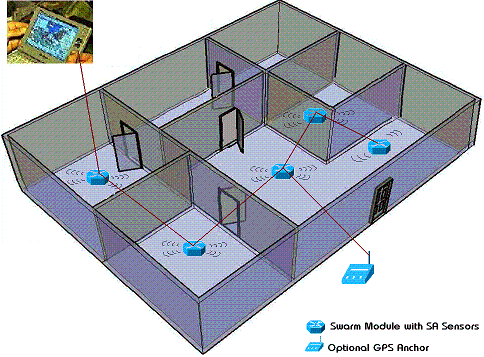The most dangerous weapon enemy forces use against the modern warfighter is the unknown. Insurgents prey on a lack of situational awareness in order to
weaken coalition forces. Providing more information to the warfighter increases his or her chance of success on the battlefield, and in difficult
urban areas. However, that information must be delivered in a timely fashion and be presented in a meaningful, effective way.
This expresses a need for a disposable sensor module with wireless networking capabilities. Each swarm module contains one or more ultrasonic
transceivers, with the capability of intelligently sending and receiving acoustic signals. An intelligent localization and characterization
algorithm running on the modules will take as input the ultrasonic sensor data, location information (e.g. from GPS, or by examining RF and/or
acoustic signal characteristics), and possibly other information as well, in order to gauge the size and shape of an enclosed area. A robust ad
hoc networking system will communicate the information to other modules, to the warfighter, and/or to a central command station. The goal is to
implement the system described using modules that are small, reliable and resilient, require minimal power, and are so inexpensive as to be expendable.
Accomplishing these goals requires synergy among several areas of active research, including sensor technology, wireless ad hoc networking, RF
localization, and area mapping.
In one possible situation, a handful of the modules could literally be thrown into the windows of a building. The modules would immediately and
without intervention become an ad hoc wireless network. Each module would determine its own position either by using GPS or by approximation
using received RF signal strength, RF signal time of arrival, and signal characteristics gathered from the onboard ultrasonic sensors. Each module
would coordinate sending and receiving acoustic signals using the signal characteristics from the ultrasonic sensors to determine room size,
locations or doors and/or windows, etc. By collaborating with nodes in neighboring rooms of the building, an idea of the entire building layout
would be formulated and sent back to the warfighter to be displayed on a handheld device. This concept is illustrated below.
